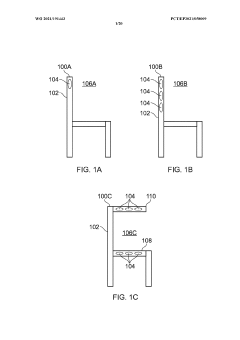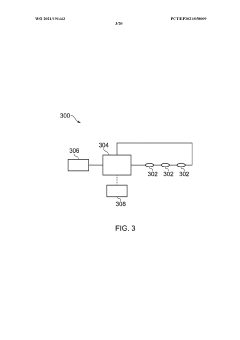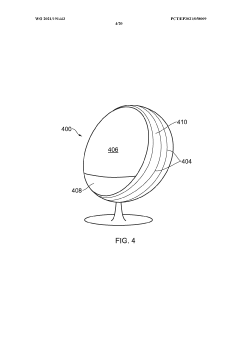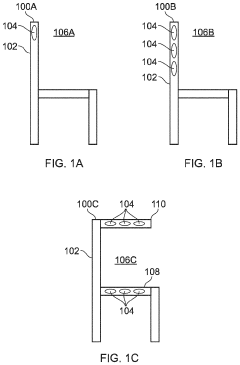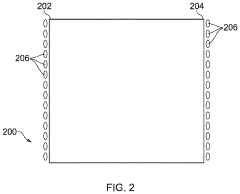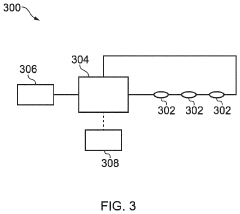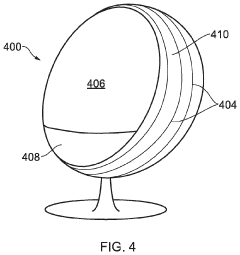Schumann Resonance: A Closer Look at its Physics
JUN 24, 20259 MIN READ
Generate Your Research Report Instantly with AI Agent
Patsnap Eureka helps you evaluate technical feasibility & market potential.
Schumann Resonance Background and Objectives
The Schumann Resonance, discovered by physicist Winfried Otto Schumann in 1952, is a set of spectral peaks in the extremely low frequency (ELF) portion of the Earth's electromagnetic field spectrum. This phenomenon is rooted in the physics of electromagnetic wave propagation within the Earth-ionosphere cavity, a natural waveguide formed between the Earth's surface and the ionosphere.
The primary objective of studying Schumann Resonance is to gain a deeper understanding of the complex interactions between the Earth's surface, atmosphere, and ionosphere. This research aims to elucidate the mechanisms behind global electromagnetic phenomena and their potential impacts on various Earth systems, including climate, weather patterns, and even biological processes.
Historically, the development of Schumann Resonance research has been closely tied to advancements in radio wave propagation theory and atmospheric physics. Early observations were limited by technological constraints, but as measurement techniques improved, so did our ability to detect and analyze these subtle electromagnetic oscillations.
The fundamental frequency of Schumann Resonance is approximately 7.83 Hz, with subsequent harmonics occurring at approximately 14.3, 20.8, 27.3, and 33.8 Hz. These frequencies are not constant but fluctuate slightly due to various factors, including solar activity, ionospheric conditions, and global lightning activity.
Recent technological advancements have enabled more precise measurements and analysis of Schumann Resonances, leading to new insights into their behavior and potential applications. Current research goals include exploring the use of Schumann Resonances as a tool for monitoring global lightning activity, studying ionospheric dynamics, and investigating possible correlations with geophysical and space weather phenomena.
Furthermore, there is growing interest in the potential biological effects of Schumann Resonances. Some researchers hypothesize that these natural electromagnetic oscillations may play a role in various physiological processes, although this remains a subject of ongoing scientific debate and investigation.
As we look to the future, the study of Schumann Resonances continues to evolve, incorporating interdisciplinary approaches that combine physics, atmospheric science, geophysics, and even aspects of biology and medicine. The ultimate aim is to develop a comprehensive understanding of this global electromagnetic phenomenon and its broader implications for Earth science and potentially human health.
The primary objective of studying Schumann Resonance is to gain a deeper understanding of the complex interactions between the Earth's surface, atmosphere, and ionosphere. This research aims to elucidate the mechanisms behind global electromagnetic phenomena and their potential impacts on various Earth systems, including climate, weather patterns, and even biological processes.
Historically, the development of Schumann Resonance research has been closely tied to advancements in radio wave propagation theory and atmospheric physics. Early observations were limited by technological constraints, but as measurement techniques improved, so did our ability to detect and analyze these subtle electromagnetic oscillations.
The fundamental frequency of Schumann Resonance is approximately 7.83 Hz, with subsequent harmonics occurring at approximately 14.3, 20.8, 27.3, and 33.8 Hz. These frequencies are not constant but fluctuate slightly due to various factors, including solar activity, ionospheric conditions, and global lightning activity.
Recent technological advancements have enabled more precise measurements and analysis of Schumann Resonances, leading to new insights into their behavior and potential applications. Current research goals include exploring the use of Schumann Resonances as a tool for monitoring global lightning activity, studying ionospheric dynamics, and investigating possible correlations with geophysical and space weather phenomena.
Furthermore, there is growing interest in the potential biological effects of Schumann Resonances. Some researchers hypothesize that these natural electromagnetic oscillations may play a role in various physiological processes, although this remains a subject of ongoing scientific debate and investigation.
As we look to the future, the study of Schumann Resonances continues to evolve, incorporating interdisciplinary approaches that combine physics, atmospheric science, geophysics, and even aspects of biology and medicine. The ultimate aim is to develop a comprehensive understanding of this global electromagnetic phenomenon and its broader implications for Earth science and potentially human health.
Applications and Market Demand
Schumann Resonances, the global electromagnetic resonances excited by lightning discharges in the cavity formed by the Earth's surface and the ionosphere, have garnered increasing attention in various applications and market sectors. The growing interest in these natural phenomena has led to the development of new technologies and products across multiple industries.
In the field of geophysics and atmospheric science, Schumann Resonances serve as valuable tools for monitoring global lightning activity and studying the Earth's ionosphere. Research institutions and weather monitoring agencies have shown a rising demand for high-precision Schumann Resonance detection systems. These systems provide crucial data for climate change studies, severe weather predictions, and ionospheric research.
The telecommunications industry has also recognized the potential of Schumann Resonances. As the demand for global communication networks continues to grow, researchers are exploring ways to utilize these resonances for long-distance, low-frequency communication systems. This technology could potentially offer an alternative or complementary method to existing satellite-based communication networks, especially in remote areas or during emergency situations.
In the realm of renewable energy, some researchers are investigating the possibility of harnessing Schumann Resonances as a novel energy source. While still in its early stages, this concept has attracted attention from energy companies and environmental organizations seeking sustainable alternatives to traditional power generation methods.
The healthcare sector has shown interest in the potential biological effects of Schumann Resonances. Some studies suggest that these natural electromagnetic frequencies may influence human circadian rhythms and overall well-being. This has led to the development of wellness products and therapies that claim to replicate or enhance the effects of Schumann Resonances, creating a niche market in the health and wellness industry.
In the field of defense and security, Schumann Resonances have applications in long-range submarine communication and detection systems. Military organizations and defense contractors are investing in research to improve underwater communication technologies based on these low-frequency resonances.
The emerging market for Schumann Resonance-based technologies also extends to the consumer electronics sector. Some manufacturers are developing devices that claim to protect users from harmful electromagnetic radiation by generating frequencies matching Schumann Resonances. While the efficacy of such products remains debated, they have found a market among consumers concerned about electromagnetic pollution.
As research into Schumann Resonances continues to advance, it is likely that new applications and market opportunities will emerge. The interdisciplinary nature of this field suggests potential for innovation across various sectors, from environmental monitoring to telecommunications and beyond.
In the field of geophysics and atmospheric science, Schumann Resonances serve as valuable tools for monitoring global lightning activity and studying the Earth's ionosphere. Research institutions and weather monitoring agencies have shown a rising demand for high-precision Schumann Resonance detection systems. These systems provide crucial data for climate change studies, severe weather predictions, and ionospheric research.
The telecommunications industry has also recognized the potential of Schumann Resonances. As the demand for global communication networks continues to grow, researchers are exploring ways to utilize these resonances for long-distance, low-frequency communication systems. This technology could potentially offer an alternative or complementary method to existing satellite-based communication networks, especially in remote areas or during emergency situations.
In the realm of renewable energy, some researchers are investigating the possibility of harnessing Schumann Resonances as a novel energy source. While still in its early stages, this concept has attracted attention from energy companies and environmental organizations seeking sustainable alternatives to traditional power generation methods.
The healthcare sector has shown interest in the potential biological effects of Schumann Resonances. Some studies suggest that these natural electromagnetic frequencies may influence human circadian rhythms and overall well-being. This has led to the development of wellness products and therapies that claim to replicate or enhance the effects of Schumann Resonances, creating a niche market in the health and wellness industry.
In the field of defense and security, Schumann Resonances have applications in long-range submarine communication and detection systems. Military organizations and defense contractors are investing in research to improve underwater communication technologies based on these low-frequency resonances.
The emerging market for Schumann Resonance-based technologies also extends to the consumer electronics sector. Some manufacturers are developing devices that claim to protect users from harmful electromagnetic radiation by generating frequencies matching Schumann Resonances. While the efficacy of such products remains debated, they have found a market among consumers concerned about electromagnetic pollution.
As research into Schumann Resonances continues to advance, it is likely that new applications and market opportunities will emerge. The interdisciplinary nature of this field suggests potential for innovation across various sectors, from environmental monitoring to telecommunications and beyond.
Current Understanding and Challenges
The current understanding of Schumann Resonance (SR) has significantly advanced since its discovery in the 1950s. This global electromagnetic phenomenon occurs in the Earth-ionosphere cavity, with fundamental frequency around 7.83 Hz and its harmonics. Recent research has refined our knowledge of SR's physical mechanisms, its relationship with global lightning activity, and its potential applications in various fields.
Modern studies have revealed that SR is not a single, constant frequency but rather a spectrum of frequencies influenced by various factors. The primary driver of SR is global lightning activity, which generates electromagnetic waves that propagate around the Earth. These waves interfere constructively and destructively, creating standing waves in the Earth-ionosphere cavity. The cavity's properties, including its size and conductivity, determine the resonant frequencies.
One of the main challenges in SR research is accurately measuring and interpreting the signals. SR amplitudes are extremely weak, typically in the range of a few picoTeslas, requiring highly sensitive magnetometers and sophisticated signal processing techniques. Environmental electromagnetic noise, both natural and anthropogenic, can significantly interfere with SR measurements, necessitating careful site selection and data filtering methods.
Another area of ongoing research and challenge is understanding the complex relationship between SR and global climate patterns. While it is known that SR is influenced by global lightning activity, which in turn is affected by climate, the exact nature of this relationship and its potential as a climate monitoring tool remains a subject of investigation. Researchers are working to develop models that can accurately predict SR parameters based on global lightning distribution and intensity.
The impact of solar activity on SR is another area of active research. Solar flares and geomagnetic storms can cause significant perturbations in the ionosphere, affecting the Earth-ionosphere cavity and, consequently, SR characteristics. Understanding these interactions is crucial for using SR as a potential tool for space weather monitoring and prediction.
Recent advancements in computational power and modeling techniques have allowed for more sophisticated simulations of SR. However, creating accurate global models that account for all the variables affecting SR, including the Earth's magnetic field, ionospheric irregularities, and day-night asymmetry, remains a significant challenge. Improving these models is essential for enhancing our understanding of SR and its potential applications.
The potential use of SR in earthquake prediction and monitoring is an exciting yet controversial area of research. Some studies have reported anomalies in SR parameters preceding major seismic events, but the reliability and mechanisms of these precursors are still debated in the scientific community. Establishing a clear, causal link between SR variations and seismic activity remains a significant challenge.
Modern studies have revealed that SR is not a single, constant frequency but rather a spectrum of frequencies influenced by various factors. The primary driver of SR is global lightning activity, which generates electromagnetic waves that propagate around the Earth. These waves interfere constructively and destructively, creating standing waves in the Earth-ionosphere cavity. The cavity's properties, including its size and conductivity, determine the resonant frequencies.
One of the main challenges in SR research is accurately measuring and interpreting the signals. SR amplitudes are extremely weak, typically in the range of a few picoTeslas, requiring highly sensitive magnetometers and sophisticated signal processing techniques. Environmental electromagnetic noise, both natural and anthropogenic, can significantly interfere with SR measurements, necessitating careful site selection and data filtering methods.
Another area of ongoing research and challenge is understanding the complex relationship between SR and global climate patterns. While it is known that SR is influenced by global lightning activity, which in turn is affected by climate, the exact nature of this relationship and its potential as a climate monitoring tool remains a subject of investigation. Researchers are working to develop models that can accurately predict SR parameters based on global lightning distribution and intensity.
The impact of solar activity on SR is another area of active research. Solar flares and geomagnetic storms can cause significant perturbations in the ionosphere, affecting the Earth-ionosphere cavity and, consequently, SR characteristics. Understanding these interactions is crucial for using SR as a potential tool for space weather monitoring and prediction.
Recent advancements in computational power and modeling techniques have allowed for more sophisticated simulations of SR. However, creating accurate global models that account for all the variables affecting SR, including the Earth's magnetic field, ionospheric irregularities, and day-night asymmetry, remains a significant challenge. Improving these models is essential for enhancing our understanding of SR and its potential applications.
The potential use of SR in earthquake prediction and monitoring is an exciting yet controversial area of research. Some studies have reported anomalies in SR parameters preceding major seismic events, but the reliability and mechanisms of these precursors are still debated in the scientific community. Establishing a clear, causal link between SR variations and seismic activity remains a significant challenge.
Existing Measurement Techniques
01 Electromagnetic field generation and measurement
Devices and methods for generating and measuring electromagnetic fields related to Schumann resonance. These systems often involve antennas, sensors, and signal processing techniques to detect and analyze the low-frequency electromagnetic waves associated with the Earth's resonant cavity.- Electromagnetic field generation and measurement: Devices and methods for generating and measuring electromagnetic fields related to Schumann resonance. These systems often involve antennas, sensors, and signal processing techniques to detect and analyze the low-frequency electromagnetic waves associated with the Earth's resonant cavity.
- Therapeutic applications of Schumann resonance: Utilization of Schumann resonance frequencies for therapeutic purposes, including stress reduction, improved sleep, and overall well-being. This involves the development of devices that generate or simulate Schumann resonance frequencies for human exposure.
- Schumann resonance in environmental monitoring: Application of Schumann resonance phenomena in monitoring environmental conditions, climate change, and global electromagnetic activity. This includes the development of sensors and systems for detecting variations in Schumann resonance parameters as indicators of environmental changes.
- Integration of Schumann resonance in electronic devices: Incorporation of Schumann resonance principles into various electronic devices and systems, such as communication equipment, navigation systems, and personal electronic devices. This involves designing circuits and components that can generate, detect, or utilize Schumann resonance frequencies.
- Schumann resonance in energy harvesting: Exploration of Schumann resonance as a potential source for energy harvesting. This includes the development of technologies to capture and convert the low-frequency electromagnetic energy associated with Schumann resonance into usable electrical power.
02 Therapeutic applications of Schumann resonance
Utilization of Schumann resonance frequencies for various therapeutic purposes, including stress reduction, improved sleep, and overall well-being. This involves the development of devices that generate or simulate Schumann resonance frequencies for human exposure.Expand Specific Solutions03 Schumann resonance in environmental monitoring
Application of Schumann resonance phenomena in monitoring and analyzing environmental conditions, including atmospheric changes, climate patterns, and potential natural disaster precursors. This involves the use of specialized sensors and data analysis techniques.Expand Specific Solutions04 Integration of Schumann resonance in electronic devices
Incorporation of Schumann resonance principles into various electronic devices and systems, such as communication equipment, navigation systems, and personal wellness devices. This includes the development of miniaturized components and circuits capable of detecting or generating Schumann resonance frequencies.Expand Specific Solutions05 Schumann resonance in energy harvesting
Exploration of Schumann resonance as a potential source for energy harvesting. This involves the development of technologies to capture and convert the low-frequency electromagnetic energy associated with Schumann resonance into usable electrical power for various applications.Expand Specific Solutions
Key Players in SR Research and Technology
The research into Schumann Resonance physics is in a mature stage, with ongoing refinements and applications. The market size for related technologies is moderate but growing, particularly in areas like environmental monitoring and electromagnetic field research. Technologically, the field is well-established, with companies like Koninklijke Philips NV and FUJIFILM Corp. contributing to advancements. Academic institutions such as California Institute of Technology and Xiamen University are also key players, pushing the boundaries of theoretical understanding and practical applications. The competitive landscape is diverse, with a mix of large corporations, specialized research institutions, and universities collaborating and competing to further develop and apply Schumann Resonance-related technologies.
California Institute of Technology
Technical Solution: Caltech has developed advanced electromagnetic sensors and data processing algorithms to study Schumann Resonances. Their approach involves using high-sensitivity magnetometers to detect extremely low-frequency electromagnetic waves in the Earth-ionosphere cavity. The institute has also created sophisticated signal processing techniques to extract Schumann Resonance signals from background noise, enabling more accurate measurements of the resonance frequencies and their variations.
Strengths: High-precision measurements, advanced signal processing. Weaknesses: Limited global coverage, potentially high equipment costs.
The Regents of the University of California
Technical Solution: The University of California system has conducted extensive research on Schumann Resonances across multiple campuses. Their approach combines theoretical physics, observational data, and advanced signal processing techniques. UC researchers have developed novel methods for extracting Schumann Resonance signals from noisy electromagnetic data, enabling more accurate measurements of resonance frequencies and amplitudes. They have also investigated the potential applications of Schumann Resonances in monitoring global lightning activity, studying ionospheric dynamics, and exploring possible links to biological systems.
Strengths: Diverse research expertise, innovative signal processing techniques. Weaknesses: Potential challenges in coordinating research efforts across multiple campuses.
Core Physics Principles of SR
A magnetic field exposure system and uses thereof
PatentWO2021191443A1
Innovation
- A magnetic field exposure system generating an amplitude-modulated low frequency magnetic field with a carrier frequency of 360 to 450 Hz and a modulation frequency of 0.5 to 100 Hz, with a field strength of 0.5 to 250 mT, specifically designed to expose organic cells or tissues to improve cell survival, proliferation, reduce stress, and enhance well-being.
A magnetic field exposure system and uses thereof
PatentPendingUS20230372726A1
Innovation
- A magnetic field exposure system generating an amplitude-modulated low frequency magnetic field with a carrier frequency of 360 to 450 Hz and a modulation frequency of 0.5 to 100 Hz, providing a field strength of 0.5 to 250 μT, specifically designed to enhance cell survival, proliferation, reduce stress, and promote tissue regeneration.
Environmental Factors Affecting SR
The Schumann Resonance (SR) is significantly influenced by various environmental factors, which can alter its characteristics and behavior. One of the primary environmental factors affecting SR is the Earth's ionosphere, which forms the upper boundary of the Earth-ionosphere cavity. Changes in the ionosphere's composition, density, and height can directly impact the resonance frequencies and amplitudes of SR.
Solar activity plays a crucial role in modulating the ionosphere and, consequently, SR. During periods of high solar activity, such as solar flares and coronal mass ejections, the ionosphere becomes more ionized and compressed. This alteration in the ionospheric conditions can lead to shifts in SR frequencies and increased signal strength. Conversely, during solar minimum periods, the ionosphere expands, potentially causing a decrease in SR frequencies.
Seasonal variations also contribute to changes in SR characteristics. The Earth's tilt and its orbit around the Sun result in varying levels of solar radiation reaching different parts of the planet throughout the year. This seasonal fluctuation affects the ionosphere's properties, leading to observable changes in SR parameters. For instance, SR frequencies tend to be slightly higher during local summer months compared to winter months.
Global lightning activity is another critical environmental factor influencing SR. As the primary excitation source for SR, changes in global thunderstorm distribution and intensity directly impact the resonance's amplitude and spectral characteristics. Regions with high thunderstorm activity, such as the tropics, contribute significantly to SR excitation. Seasonal shifts in thunderstorm patterns, like the movement of the Intertropical Convergence Zone, can cause variations in SR measurements.
Atmospheric conditions near the Earth's surface also play a role in SR behavior. Changes in temperature, humidity, and atmospheric pressure can affect the propagation of electromagnetic waves within the Earth-ionosphere cavity. For example, increased water vapor content in the atmosphere can lead to enhanced absorption of certain frequency components of SR.
Human activities and technological advancements have introduced additional environmental factors affecting SR. The global increase in electromagnetic noise from power lines, communication systems, and other electronic devices can interfere with SR measurements and potentially alter its natural characteristics. Furthermore, large-scale changes in land use, such as deforestation or urbanization, may indirectly influence SR by altering local atmospheric conditions and potentially affecting regional lightning patterns.
Understanding these environmental factors and their complex interactions is crucial for accurately interpreting SR measurements and utilizing them in various scientific applications, such as global lightning monitoring, ionospheric studies, and potentially even climate change research.
Solar activity plays a crucial role in modulating the ionosphere and, consequently, SR. During periods of high solar activity, such as solar flares and coronal mass ejections, the ionosphere becomes more ionized and compressed. This alteration in the ionospheric conditions can lead to shifts in SR frequencies and increased signal strength. Conversely, during solar minimum periods, the ionosphere expands, potentially causing a decrease in SR frequencies.
Seasonal variations also contribute to changes in SR characteristics. The Earth's tilt and its orbit around the Sun result in varying levels of solar radiation reaching different parts of the planet throughout the year. This seasonal fluctuation affects the ionosphere's properties, leading to observable changes in SR parameters. For instance, SR frequencies tend to be slightly higher during local summer months compared to winter months.
Global lightning activity is another critical environmental factor influencing SR. As the primary excitation source for SR, changes in global thunderstorm distribution and intensity directly impact the resonance's amplitude and spectral characteristics. Regions with high thunderstorm activity, such as the tropics, contribute significantly to SR excitation. Seasonal shifts in thunderstorm patterns, like the movement of the Intertropical Convergence Zone, can cause variations in SR measurements.
Atmospheric conditions near the Earth's surface also play a role in SR behavior. Changes in temperature, humidity, and atmospheric pressure can affect the propagation of electromagnetic waves within the Earth-ionosphere cavity. For example, increased water vapor content in the atmosphere can lead to enhanced absorption of certain frequency components of SR.
Human activities and technological advancements have introduced additional environmental factors affecting SR. The global increase in electromagnetic noise from power lines, communication systems, and other electronic devices can interfere with SR measurements and potentially alter its natural characteristics. Furthermore, large-scale changes in land use, such as deforestation or urbanization, may indirectly influence SR by altering local atmospheric conditions and potentially affecting regional lightning patterns.
Understanding these environmental factors and their complex interactions is crucial for accurately interpreting SR measurements and utilizing them in various scientific applications, such as global lightning monitoring, ionospheric studies, and potentially even climate change research.
Potential Impact on Climate Studies
The potential impact of Schumann Resonance on climate studies is a topic of growing interest among researchers. As our understanding of the Earth's electromagnetic environment deepens, scientists are exploring how these natural resonances might influence or interact with various atmospheric and climatic processes.
Schumann Resonances, being global electromagnetic phenomena, have the potential to serve as indicators of global temperature changes. Some studies suggest that variations in the resonance frequencies and amplitudes could be correlated with global temperature fluctuations. This relationship, if further validated, could provide an additional tool for monitoring and understanding climate change on a global scale.
Furthermore, Schumann Resonances may play a role in the Earth's energy balance. The resonances are intimately connected with the ionosphere, which is a crucial component of the Earth's atmosphere. Changes in the ionosphere's properties, potentially influenced by climate change, could affect the characteristics of Schumann Resonances. This interplay between the ionosphere, climate, and Schumann Resonances presents an intriguing area for future research.
The global nature of Schumann Resonances also makes them potentially valuable for studying large-scale atmospheric phenomena. For instance, researchers are investigating whether these resonances could provide insights into the behavior of tropical cyclones or other widespread weather patterns. The ability to monitor such phenomena on a global scale could enhance our understanding of climate dynamics and improve weather prediction models.
Additionally, Schumann Resonances might offer a unique perspective on the coupling between different layers of the atmosphere. As these resonances propagate through the entire Earth-ionosphere cavity, they could potentially carry information about the state of various atmospheric layers. This could lead to new methods for studying atmospheric coupling processes, which are crucial for understanding climate systems.
Lastly, the study of Schumann Resonances in the context of climate research may open up new avenues for investigating the Earth's electromagnetic environment and its potential influences on biological systems. While still a subject of debate, some researchers propose that these resonances might have subtle effects on Earth's biosphere, potentially influencing various ecological processes that could be relevant to climate studies.
Schumann Resonances, being global electromagnetic phenomena, have the potential to serve as indicators of global temperature changes. Some studies suggest that variations in the resonance frequencies and amplitudes could be correlated with global temperature fluctuations. This relationship, if further validated, could provide an additional tool for monitoring and understanding climate change on a global scale.
Furthermore, Schumann Resonances may play a role in the Earth's energy balance. The resonances are intimately connected with the ionosphere, which is a crucial component of the Earth's atmosphere. Changes in the ionosphere's properties, potentially influenced by climate change, could affect the characteristics of Schumann Resonances. This interplay between the ionosphere, climate, and Schumann Resonances presents an intriguing area for future research.
The global nature of Schumann Resonances also makes them potentially valuable for studying large-scale atmospheric phenomena. For instance, researchers are investigating whether these resonances could provide insights into the behavior of tropical cyclones or other widespread weather patterns. The ability to monitor such phenomena on a global scale could enhance our understanding of climate dynamics and improve weather prediction models.
Additionally, Schumann Resonances might offer a unique perspective on the coupling between different layers of the atmosphere. As these resonances propagate through the entire Earth-ionosphere cavity, they could potentially carry information about the state of various atmospheric layers. This could lead to new methods for studying atmospheric coupling processes, which are crucial for understanding climate systems.
Lastly, the study of Schumann Resonances in the context of climate research may open up new avenues for investigating the Earth's electromagnetic environment and its potential influences on biological systems. While still a subject of debate, some researchers propose that these resonances might have subtle effects on Earth's biosphere, potentially influencing various ecological processes that could be relevant to climate studies.
Unlock deeper insights with Patsnap Eureka Quick Research — get a full tech report to explore trends and direct your research. Try now!
Generate Your Research Report Instantly with AI Agent
Supercharge your innovation with Patsnap Eureka AI Agent Platform!
